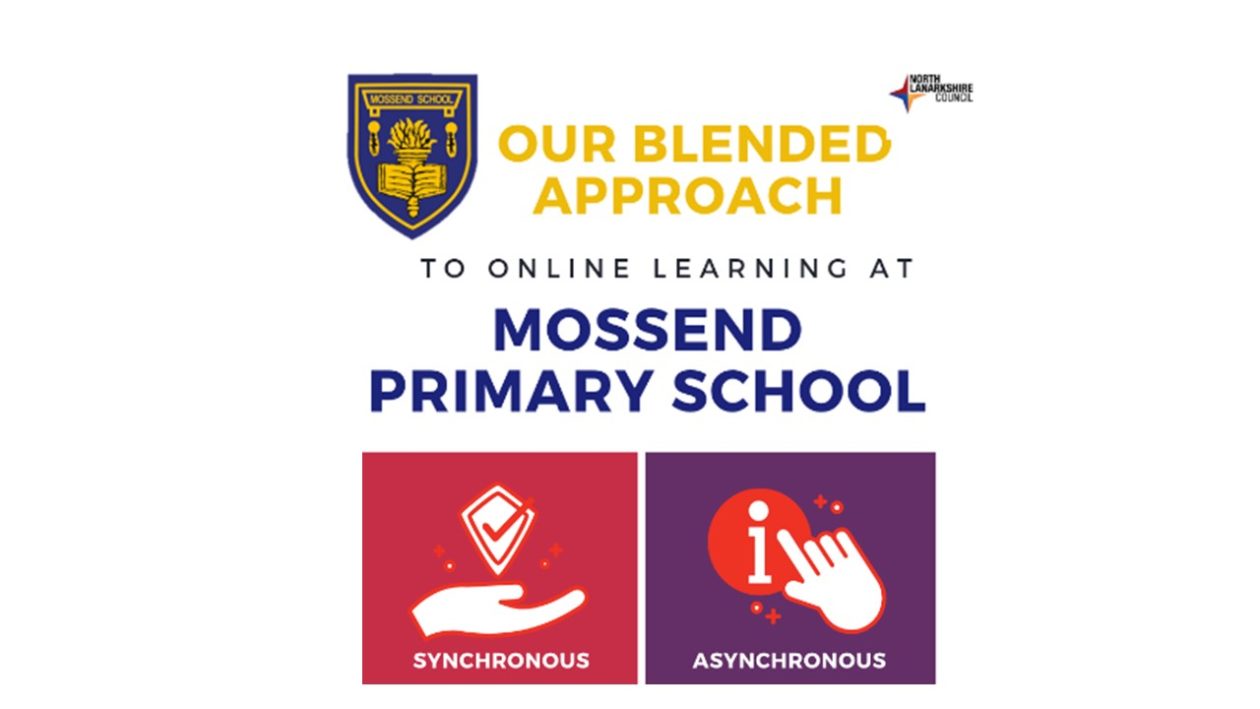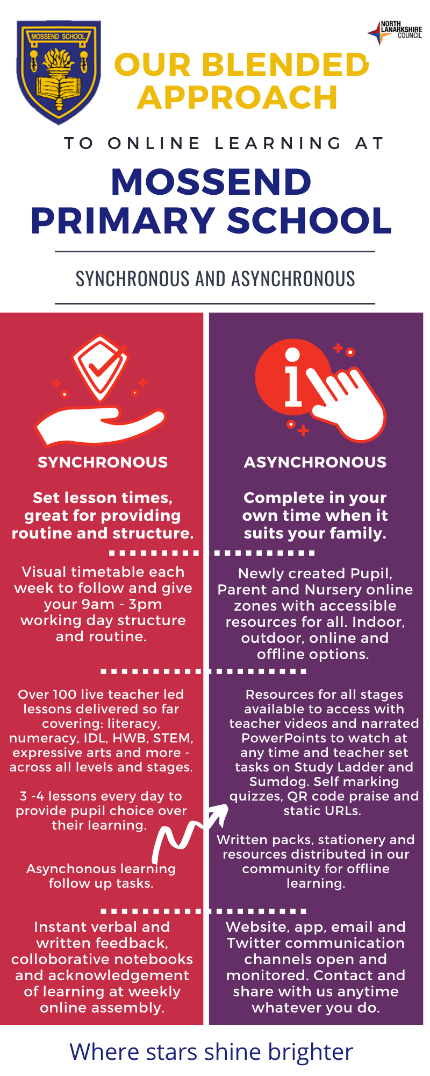As discussed in our first blog in this series, our focus for term 4 was on the health and wellbeing of the children and therefore our priority was to ensure that we did not add further stress to families at an already unsettling time for our children by expecting too much or demanding that all children accessed digital content. So, we truly made use of a blended approach to offer as much flexibility as we could with traditional and flipped learning opportunities and synchronous and asynchronous tasks to allow our families to do what worked for them, without judgement or worry that their child would ‘fall behind’.
Later in this blog series, we will detail what our approach at Mossend Primary and Nursery Class will be should blended learning come into force next session, as clearly the focus will change within the context of a part-time school and digital learning mix, nevertheless, we will still strive to offer flexibility for our families as we believe that a blend of digital approaches is the best way to sustain engagement.
Similarly, we replicated this approach with our staff, sending out a weekly sign-up sheet to volunteer to deliver lessons, with absolutely no pressure as detailed on our previous blog.
A – The accessibility of the digital learning we were offering was another barrier that we had to overcome and we will discuss next week in greater detail the applications we chose to use and the reasons why.
However, we did make use of the accessibility features within Immersive Reader on Class Notebook in our Microsoft Teams to highlight to our families how this could be used to support reading and writing at home, particularly for children with additional support needs. Furthermore, we utilised Microsoft Office Lens as a way to take text and make it accessible, distributing via Class Notebooks and assignments within Microsoft Teams. This provided support to some of our families and differentiated the work we were offering to our pupils.
Furthermore, we embedded pupil voice within our digital approach by asking the children what they wanted to learn, involving our Digital Leaders to assist and take ownership with the Microsoft Team and encouraging children to help their peers with navigation and how to access content when new pupils joined. We even had a P7 girl plan and deliver an arts and crafts lesson on her own in Microsoft Team to the school; the true essence of a confident individual and leading their own learning.
Our Microsoft Team was accessible to all ages and stages of child and by ensuring that the pupils had a say over their learning, allowing them to take ownership of it, listening to their voice and making them part of their learning it did become one full school Team and increased our overall engagement – the children wanted to be part of it, they wanted to learn and they looked forward to the lessons!
This was evident at our whole school assembly on a Friday, which quickly became a highlight of the week for everyone.
S – The key to our sustained engagement was down to the support we offered, we needed our parents and carers to know that we understood they were not teachers and that we did not expect them to replicate the school day at home, however, they knew their child better than anyone and we would be here to help engage them in their learning regardless of the route they chose.
Our flexible approach allowed families to focus on the needs of their child, without the worry of them ‘falling behind’ or the pressure of them trying to learn new digital skills. We made use of an “open-door policy” and ensured that our Twitter account was manned between 9 am – 3 pm each weekday, that we had Microsoft Team Moderators daily and that emails were responded to quickly. Digital support was always on hand.
Previously, if a parent or carer needed to discuss something they would simply come down to the school and ask at our office, so it was important for us that our communication channels remained opened and that our families knew they could contact us during the school closure. Some reached out just for reassurance, to ask for advice on a concept or if the work they were completing was at the right level and others just to ‘check-in’.
Nevertheless, not every child in our school did engage in learning during the lockdown and we did not hear from every family, although we made phone calls and efforts to offer support it may have just been too late. If any school is to increase engagement in digital learning next session, then working with these families to understand the barriers and challenges for them and identifying what we (schools, communities, local authorities, government) can do to help and support them will be essential, but that must take place before any future lockdown happens in order to Get It Right For Every Child (GIRFEC) next time.
T – We all love a ‘well done’ and some positive recognition for work completed, so we quickly introduced a gold star system to fit in with our “Where Stars Shine Brighter” school vision.
Every piece of work that was shared with us on our Microsoft Team or Twitter was acknowledged, recognised and the effort praised in a timely manner and each child was awarded a virtual gold star.
This was not about rewarding those who were engaging with the Microsoft Team or Twitter, it was about rewarding the work that was shared with us and the effort that had gone into it regardless if it was offline work like cooking, baking, gardening, building or a worksheet – it didn’t matter – learning had taken place and this needed to be celebrated.
At the end of the week, we would celebrate all the work shared at our school assembly and put the name of every pupil who had earned a star into a weekly draw with the winner receiving a £5 E-voucher for Amazon emailed directly to their parent or carer.
The fact we implemented this system right at the beginning of our journey was paramount to our success and absolutely the right time as it gave our children a real incentive to get involved and we know they enjoyed receiving their virtual stars each time they shared work with us. The children shared their work for the intrinsic motivation of being praised publicly (using the praise feature within Microsoft Teams) and the feelings that the recognition gave them, the weekly Amazon voucher was just a nice add on for those children who were extrinsically motivated and a further supportive carrot for their parents or carers to dangle in motivating them to get logged in each day.
Our Microsoft Team was successful because there was a range of cogs working in the background in a timely manner, things did not just happen. We would meet virtually at the beginning and the end of each week to create the timetable for the following week, send out the staff sign up sheet and then look to fill any gaps. We constantly reviewed upcoming events or celebrations such as Father’s Day, World Smile Day and VE Day to ensure our lessons were timely and that we were able to tap into the natural excitement of events like Easter and Star Wars Day, thus increasing engagement.
In summary, whilst we may not have had the flashing lights, we did have the (one way) camera and the plenty of action. We utilised our talented staff to offer diversity in our lessons, ensuring they were timely and relevant. We offered a flexible and supportive approach to families with communication at the heart and we achieved this by moderating Twitter and Microsoft Teams, acknowledging work, ensuring pupils had a voice with involvement in their learning and praising and rewarding the work that was being shared back to us. All of the cogs were moving in the background to spark and sustain engagement in our digital learning and our hope for the future is to continue to increase this engagement by identifying what else we need to do to Get It Right For Every Child (GIRFEC).
John Dewey once said, “If we teach today as we taught yesterday, we rob our children of tomorrow” (Dewey,1916), teachers are always going to be up against the lights, camera and action of the latest blockbuster, video game or must have gadget; so we must continually find new, creative and inventive ways of engaging our children in their learning,
Lockdown 2020 certainly gave us all the unique chance to ‘test the waters’ with remote digital learning and we think John Dewey would have been proud of our approach.
Patricia McKay is the Depute Head Teacher at Mossend PS & NC in North Lanarkshire and Gordon Reid is a class teacher and ICT Co-ordinator. Together they facilitated and led the remote learning strategy for the school.
Mossend PS & NC is a non-denominational school situated in Bellshill, North Lanarkshire. The school has 382 pupils and there are 40 children in the nursery attached to the school.
Twitter: @mossendps @Mr_G_Reid
https://blogs.glowscotland.org.uk/nl/mossendps/
References
Dewey, J. (1916). Democracy and Education. New York: Free Press Available at: http://www.ilt.columbia.edu/publications/dewey.html [Accessed 15 July 2020].
Hazell, W., 2018. Teach With Video Games, Schools Told. [online] Tes. Available at: https://www.tes.com/news/teach-video-games-schools-told [Accessed 15 July 2020].




